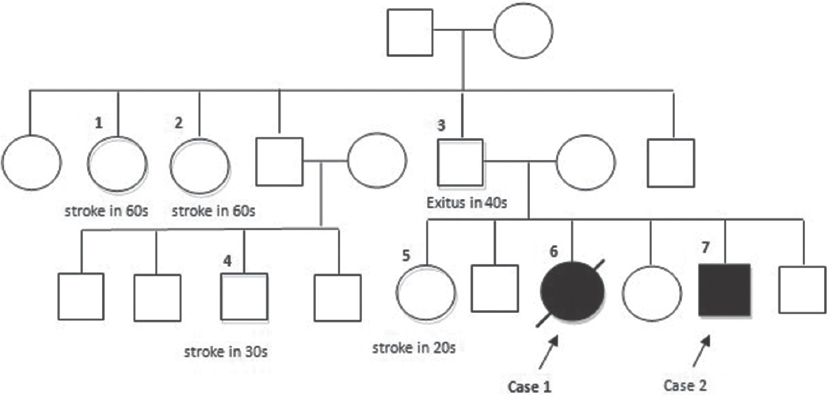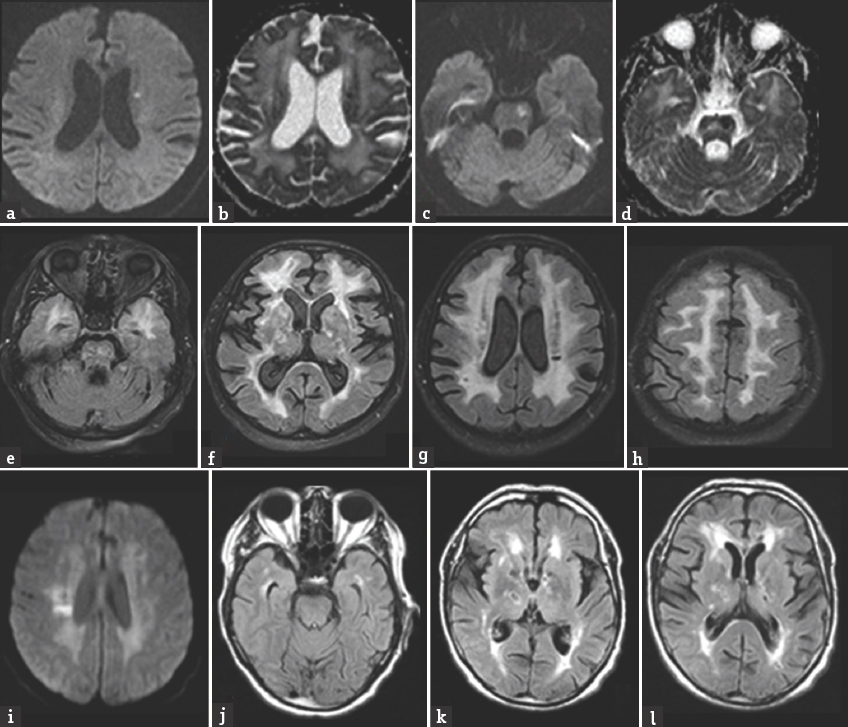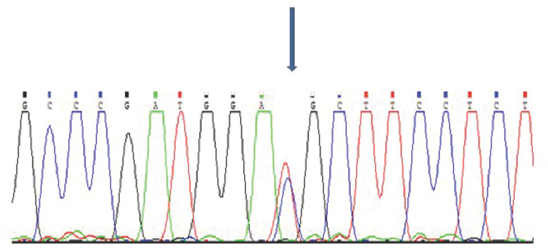Translate this page into:
R141C Mutation of NOTCH3 Gene in Cerebral Autosomal Dominant Arteriopathy with Subcortical Infarcts and Leukoencephalopathy
Address for correspondence: Dr. Halil Onder, Department of Neurology, Faculty of Medicine, Hacettepe University, Sihhiye 06100, Ankara, Turkey. E-mail: halilnder@yahoo.com
This is an open access article distributed under the terms of the Creative Commons Attribution-NonCommercial-ShareAlike 3.0 License, which allows others to remix, tweak, and build upon the work non-commercially, as long as the author is credited and the new creations are licensed under the identical terms.
This article was originally published by Medknow Publications & Media Pvt Ltd and was migrated to Scientific Scholar after the change of Publisher.
Sir,
Cerebral autosomal dominant arteriopathy with subcortical infarcts and leukoencephalopathy (CADASIL) is caused by single gene mutations in the NOTCH3 gene, which encodes the NOTCH3 receptor protein.[1] More than 170 mutations in the NOTCH3 gene have been found so far.[2] All NOTCH3 variants reported to have no noticeable phenotypic difference. We herein report a family with R141C mutation, enabling us to discuss the importance of genetic diagnosis of this rare disease.
A 43-year-old woman [III:6, Figure 1] was admitted to our center with complaints of numbness, a slightly weakness on the right side, and speech impairment which had suddenly and concurrently started 1 day ago. Medical history was unremarkable except for hypertension and hypothyroidism, both of which were under good control. At admission, neurological examination revealed dysarthria along with hemihypesthesia and slight hemiparesis on the right side. Brain magnetic resonance imaging (MRI) disclosed acute lacunar infarcts located in the left corona radiata and the anterolateral part of the mid-pons [Figure 2a–d]. Brain MRI also documented coalescing white matter hyperintensities involving the temporal poles and the external capsules heavily along with multiple chronic lacunes [Figure 2e–h]. MRI pattern was suggestive for diagnosis of CADASIL. Further neurological evaluation disclosed the presence of long-standing migrainous headaches for many years and dementia with pseudobulbar features. DNA sequencing analysis detected heterozygous p. Arg141Cys (c.421C>T) in exon 4 of the NOTCH3 gene [Figure 3]. Genomic DNA was isolated from the peripheral blood samples using salting-out method. Exon 3, 4, 5, and 6 of the NOTCH3 gene were amplified by the polymerase chain reaction (PCR). For sequencing, the PCR products were purified using the ExoSAP-IT (GE Healthcare Bio-Sciences, Cleveland, USA), following the manufacturer's protocol. Sequence reactions were run on an ABI Prism 3130xl DNA Sequencer (Applied Biosystems, Foster City, CA, USA) and analyzed by sequencing analysis software, version 5.4 (Applied Biosystems, Foster City, CA, USA). Her follow-up during the 1st year of admission was uneventful.

- Turkish cerebral autosomal dominant arteriopathy with subcortical infarcts and leukoencephalopathy pedigree

- Magnetic resonance imaging of case 1 showing acute lacunar infarcts located in the left corona radiata and the anterolateral part of the mid-pons (a-d). Other images of case 1 showing coalescing white matter hyperintensities involving the temporal poles and the external capsules heavily along with multiple chronic lacunes (e-h). Magnetic resonance imaging of case 2 showing acute lacune along with advanced white matter disease and chronic lacunes (i-l)

- Chromatograms showing sequencing profile of the patient. Arrow shows the mutation site
Family history [Figure 1] revealed that symptoms compatible with cerebrovascular disease were evident in her father, two brothers, and one of the cousins. There was also accumulation of stroke in the family, but we were not able to clarify their nature further. We have only studied one of her brothers [III:7 Figure 1]. He was a 50-year-old modestly hypertensive male with history of recurrent strokes. The last episode was manifested with dysarthria and facial and arm paresis on the right side. Cranial MRI obtained after this stroke showed an acute lacune along with advanced white matter disease and chronic lacunes but not diagnostic features for CADASIL [Figure 2i–l]. Given absence of significant atherosclerosis risk factors and normal craniocerebral vasculature, CADASIL syndrome was considered in the differential diagnosis, nonetheless genetic test was not feasible.
The genetic analysis of CADASIL is expensive, effortful, and time-consuming due to the notably large size of NOTCH3, and more than 170 mutations can be found in any of the 22 of 33 exons encoding for a single-pass transmembrane receptor of 2321 amino acids with an extracellular domain comprising 34 epidermal growth factor repeats (EGFR). However, by virtue of the mutations clustered in exons 3 and 4 encoding EGFR 2–5, genetic testing is still commercially available.
CADASIL mutations have been reported worldwide in all ethnic groups including Turkish population. Albeit p. Arg141Cys mutation is frequent in Europeans up to 15%, this mutation is rare in other populations[3] and, to our best knowledge, has previously been described only in a single case of Turkish origin.[4] Hence, this report constitutes the second reported case of the p. Arg141Cys mutated CADASIL patient in Turkish origin as well as pointing out the widespread distribution to this mutation.
In a large case series from Turkey, no genetic mutations were specified. In this multicenter database, a wide variety of mutations were found in 25 of 48 patients included in this study.[5] Interestingly, almost half of CADASIL patients have not disclosed regular/frequent mutations. Several case reports found p. Arg90Cys (c.346C>T),[6] p. Arg110Cys (c.460C>T),[7] p. Arg133Cys (c.475C>T),[89] and p. Arg153C>T (c.533C>T)[10] mutations in the NOTCH3 gene of Turkish patients. Our case broadens the position of the p. Arg141Cys (c.421C>T) mutation in the list. These observations highlight connection of wide variety of mutation locations to CADASIL syndrome in Turkey similar to the situation in Western societies. This large number of mutations in this very wide gene makes testing a very time-consuming process. For this reason, routine genetic testing of the whole gene is not always performed in CADASIL, and occidental medical databases indicate that most of the abnormalities (up to 90% of cases) tend to occur in certain parts of the gene. However, we do not know the same strategy would be valid in our country. Although we performed only a case description, this observation can still suggest that the spectrum of NOTCH3 mutations might be different in people of Turkish origin than in individuals of Caucasian ethnicity. Therefore, further analysis of Turkish population with CADASIL might be necessary to constitute a nation-specific mutation screening paradigm until new technologies become available to screen the whole gene to look for abnormalities.
Financial support and sponsorship
Nil.
Conflicts of interest
There are no conflicts of interest.
REFERENCES
- Notch3 mutations in CADASIL, a hereditary adult-onset condition causing stroke and dementia. Nature. 1996;383:707-10.
- [Google Scholar]
- Two Japanese CADASIL families with a R141C mutation in the Notch3 gene. Intern Med. 2001;40:1144-8.
- [Google Scholar]
- Clinical and radiological features in CADASIL and NOTCH3-negative patients: A multicenter study from Turkey. Eur Neurol. 2014;72:125-31.
- [Google Scholar]
- CADASIL syndrome in a large Turkish kindred caused by the R90C mutation in the Notch3 receptor. Eur J Neurol. 2002;9:23-8.
- [Google Scholar]
- The R110C mutation in Notch3 causes variable clinical features in two Turkish families with CADASIL syndrome. J Neurol Sci. 2006;246:123-30.
- [Google Scholar]
- Cerebral autosomal dominant arteriopathy with subcortical infarcts and leukoencephalopathy (CADASIL) in two siblings with neuropsychiatric symptoms. Psychosomatics. 2013;54:594-8.
- [Google Scholar]
- A case report about CADASlL: Mutation in the NOTCH 3 receptor. Acta Neurol Taiwan. 2009;18:262-6.
- [Google Scholar]





